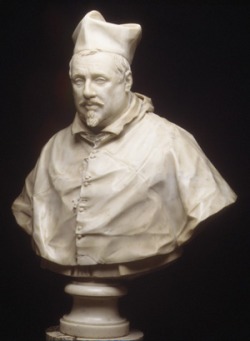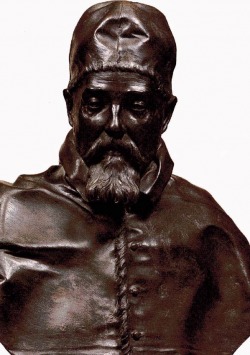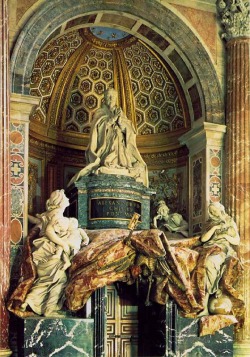Bernini's Patrons
Pope Paul V Borghese

Pope Paul V was young Bernini's first patron. At the age of 11 he carved a bust that so impressed the Pope that he put Bernini's education into his own hands. Bernini remained at the service of the Borghese family for years, making a bust (shown) for the Pope and carving several of his most famous sculptures for his nephew, Cardinal Scipione Borghese.
Bust of Pope Paul V
Completed: 1618
Carrara marble, height 34 cm
Galleria Borghese, Rome
Source: Web Gallery of Art
Cardinal Scipione Borghese

Cardinal Scipione Borghese was the nephew of Pope Paul V, and a wealth art patron. He had a large villa near the Pincian Gate in Rome that was heavily adorned with bas-reliefs and statue-filled niches in Bernini's time. Today the villia is a museum that houses many works of art, including several scuptures by Bernini, including David, Apollo and Daphne, The Goat Amalthea, Aeneas, Anchises and Ascanius, Rape of Proserpina, and the two almost identical busts of the Cardinal, one of which is shown.
Bust of Scipione Borghese
1632
Marble, height 78 cm
Galleria Borghese, Rome
Source: MetMuseum.org
Pope Gregory XV Ludovisi

Though Pope Gregory XV's pontificate lasted only 29 months he still managed to commission the young but already famous Bernini to "complete" some ancient statues that were missing body parts. Gregory XV did not manage to commission to do much more than that, however; most of Bernini's efforts were still going towards Cardinal Borghese.
Bust of Pope Gregory XV
Completed: 1621
Marble
Private Collection: Joseph M. and Toby Tanenbaum
Source: 1st Art Gallery
Pope Urban VIII Berberini

Pope Urban VIII (Maffeo Barberini) was not only Bernini's greatest patron, but the Catholic Church's greatest art patron. Pope Paul V entrusted an 11 year-old Bernini to Cardinal Barberini when he decided that Bernini's education was a matter of importance to the church. Urban VIII summoned Bernini soon after he assumed the papacy in 1623. The Pope recommended that Bernini expand his skills into painting and architecture, and in 1629 he was named Architect of St. Peter's.
During Urban VIII's 21-year pontificate Bernini was given more than 30 commissions for fountains, tombs, portraits, figures, church decorations, and architectural projects. Bernini had so much work that he set up a studio that employed virtually every gifted sculptor in Rome. Among Urban VIII's commissions for Bernini were several works within the basilica, including the baldachin above St. Peter's tomb, which is so large that it can be classified as architecture as well as sculpture.
Bust of Pope Urban VIII
Completed: 1633
Bronze
Museo Sacro, Musei Vaticani, Vatican
Source: Web Gallery of Art
Pope Innocent X Pamphilj

Urban VIII had left the Church's treasury greatly diminished, which greatly angered Innocent X. Since Bernini was so closely associated with the former Pope and had failed at building the bell towers to St. Peter's he was temporarily disgraced. At first he received few commissions from the Pope, none architectural.
Pope Innocent X changed his mind about Bernini after seeing a model of his design for the Four River Fountain. The fountain brought Bernini back into the Pope's good graces and ended his period of disgrace.
Bust of Pope Innocent X
Completed: 1647
Marble
Galleria Doria Pamphilj, Rome
Source: Web Gallery of Art
Pope Alexander VII Chigi

Pope Alexander VII, who assumed the papacy in 1655, was an old friend of Bernini, and with his pontificate Bernini's control over the building industry in Rome was fully restored and even augmented. Chigi commissioned Bernini to do one of his most magnificent and most seen works: the Piazza of St. Peter's.
Photograph: The Tomb of Pope Alexander VII
Completed: 1678
Marble and gilded bronze
Basilica di San Pietro, Vatican
Source: Web Gallery of Art
Pope Clement IX Rospigliosi

Celment IX was Bernini's last great papal patron. Though he was only pope from 1667-1669 he commissioned an aged Bernini to redesign the S. Angelo Bridge and adorn it with ten statues(pictured).
Photo: Ponte Sant'Angelo
Completed: 1669
Marble
Rome
Source: Emily Harris
